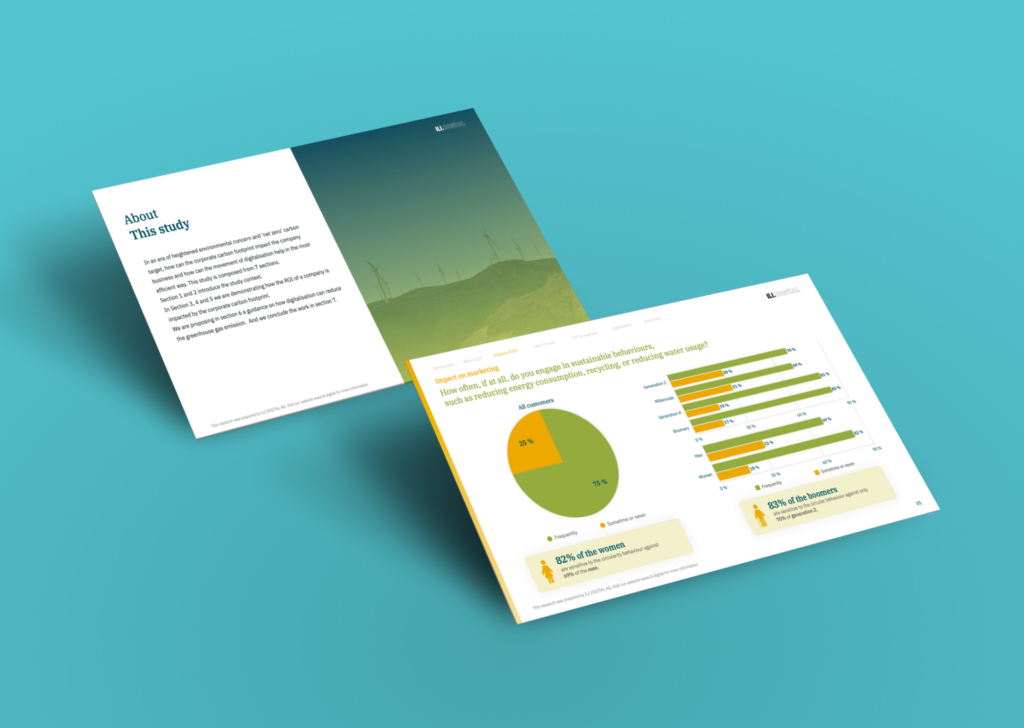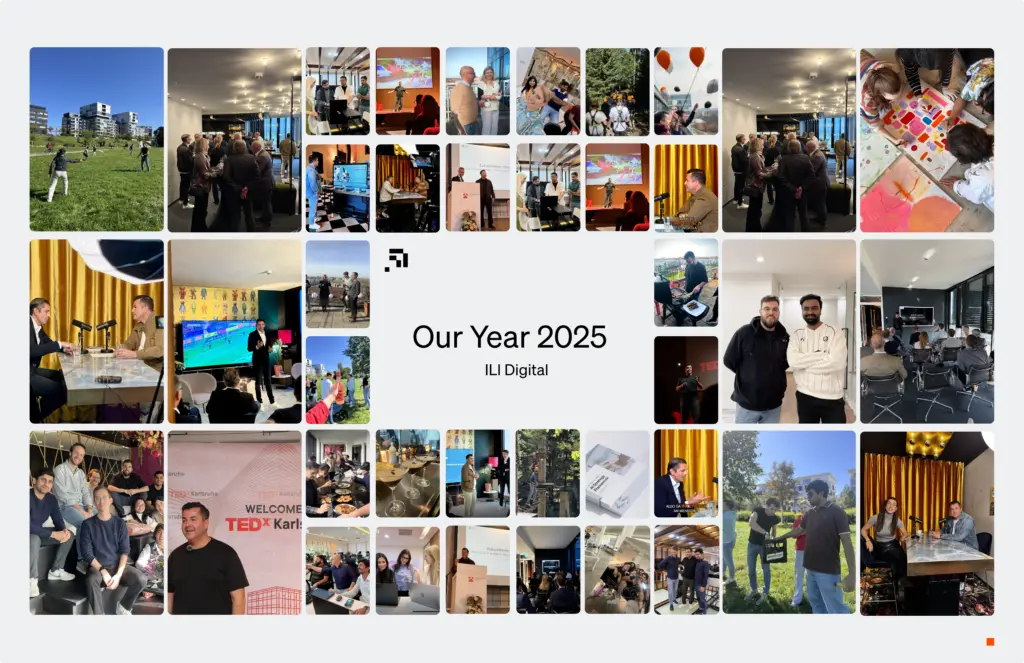Understanding and improving a company’s carbon footprint is essential not only for regulatory compliance but also for achieving a competitive edge. In this article we summarized our key findings on the impact of Corporate Carbon Footprint (CCF) on Return of Investment of companies (ROI) and presents actionable insights through real-world use cases and digital solutions.
What is Corporate Carbon Footprint (CCF)
The Corporate Carbon Footprint (CCF) is the total amount of greenhouse gas (GHG) emissions caused directly or indirectly by a company’s activities. This includes emissions from:
- Production processes
- Energy consumption
- Supply chain activities
CCF is typically categorized into three scopes. Managing Scope 1, Scope 2, and Scope 3 emissions can lead to improved customer trust and better alignment with global sustainability goals.
- Scope 1: Direct emissions from owned or controlled sources. (e.g., process emissions)
- Scope 2: Indirect emissions from the consumption of purchased energy. (e.g., heating or cooling)
- Scope 3: All other indirect emissions across the value chain. (e.g., business trips or waste)
Why CCF Matters and How It Can Boost ROI
The world is in a state of climate emergency, and efforts must be made to keep the planet safe. The emission of greenhouse gases is significantly altering the composition of the atmosphere. The average world temperature has risen between 1.1 and 1.2°C.
We can no longer stand by and watch as the consequences of global warming have become irreparable.

Studies show that businesses with comprehensive carbon reduction strategies experience an increase in profitability due to energy savings, tax breaks, and stronger market positioning. Properly managing and reducing CCF offers significant opportunities to boost your Return on Investment (ROI). Here’s how:
Regulatory Compliance
European climate law makes reaching the EU’s climate goal of reducing EU emissions by at least 55% by 2030 a legal obligation. EU countries are working on new legislation to achieve this goal and to make the EU climate neutral by 2050.
Impact on Sales & Finance
Brands that embrace carbon reduction attract and retain more loyal customers. To accomplish the net zero emission corporates should anticipate the regulation.
Cost Efficiency
Reducing emissions often correlates with decreased energy consumption, which leads to substantial cost savings over time.
Reputation Enhancement
Consumers and investors are increasingly drawn to companies that demonstrate a commitment to sustainability, improving brand value and customer loyalty.
Based on our study, 67% of customers would stop buying from companies that are not transparent about their environmental impact.



Risk Mitigation
Anticipating regulations like carbon neutrality targets ensures you avoid fines, which can be costly, while positioning your brand as a market leader.
Customer Engagement
- 66% of consumers now prioritize sustainability in their purchasing decisions.
- 31% of the customers are ready to leave a brand for a more sustainable product or service even if they will pay more.
Innovation Catalyst
Companies that take proactive measures in carbon management often drive innovation, whether through new technology investments, efficient production processes, or smarter resource use.
How to Join Forces: Twin Transformation – Sustainability and Digitalization
To reduce greenhouse gas (GHG) emissions, it requires a systematic and comprehensive approach that involves all levels of the organization, including management, employees, and suppliers. To do so, we propose the following steps:
1. Conducting a GHG emissions inventory
Track all direct and indirect emissions to identify key sources and areas for improvement.
2. Setting reduction targets
Establish clear, measurable goals to reduce emissions in alignment with sustainability benchmarks.
3. Define the solution to adress the situation
Identify and implement technology-driven strategies to minimize your carbon footprint.
4. Evaluate and adjust the inventory
Continuously review and update your emissions data to ensure progress and adapt as needed.

Download the Report
Read the full study, in which our experts demonstrate how the company Return of investment is impacted by the Corporate Carbon Footprint, and we propose a guidance on how digitalisation can reduce the greenhouse gas emission.
ILI Digital Sustainable Success: gecco2
One of our most successful projects at ILI Digital, gecco2, involved the collaboration with Volksbank Digital Solutions. We integrated digital solutions to help small and medium-sized enterprises track their environmental impact. Using gecco2’s carbon monitoring and reduction strategies, SMEs can cut down its emissions, enhanced its sustainability reporting, and improved operational efficiencies.
The project demonstrates the potential of digital tools in not only enhancing sustainability efforts but also improving financial returns. The key takeaways include:
- Reduction in operational emissions by 20%.
- Improved sustainability tracking and reporting using real-time data.
- Strengthened public image as a leader in sustainable banking.
- Increased operational efficiency, helping companies align with EU’s regulatory frameworks like Fit for 55
Read the Case Study
Discover how we developed the Corporate Carbon Footprint (CCF) Calculator to help small and medium-sized enterprises track their environmental impact. Read more ⇲

Leveraging AI for Sustainability
Artificial Intelligence (AI) is revolutionizing sustainability practices, enabling companies to analyze vast datasets, optimize operations, and reduce emissions.
- GHG Emissions of AI – A 2022 paper in Nature Climate Change estimates that cloud and hyperscale data centers are responsible for 0.1%-0.2% of global GHG emissions.
The Impact of AI on Sustainability
AI has the potential to unlock insights that could help mitigate 5%-10% of global greenhouse gas (GHG) emissions by 2030. The potential for AI to significantly reduce global GHG emissions far outweighs its relatively small contribution to those emissions, highlighting its crucial role in advancing sustainability. Here’s how AI can enhance your company’s sustainability efforts:
- Predictive Analytics for Emission Reduction – AI helps businesses forecast energy consumption patterns and optimize processes to minimize carbon output.
- Supply Chain Optimization – By analyzing supply chain data, AI identifies inefficiencies and suggests greener alternatives that reduce emissions.
- Automation for Sustainability Reporting – Automate carbon reporting processes, ensuring accuracy and compliance with regulatory frameworks.

Discover our AI Tailored Solutions
Get a glimpse of how our team of AI experts at ILI Digital can leverage AI solutions tailored to your needs. Read more ⇲
Get Your Copy
FAQs
What is Corporate Carbon Footprint (CCF)?
The CCF measures the total greenhouse gas emissions a company is responsible for, including direct and indirect emissions from production, energy consumption, and the supply chain.
How does reducing CCF improve ROI?
Reducing your CCF leads to lower energy costs, tax benefits, improved brand reputation, and a stronger market position, ultimately boosting your company’s ROI.
What is the twin transformation of sustainability and digitalization?
The twin transformation refers to integrating digital technologies with sustainability initiatives to streamline operations, reduce emissions, and enhance overall efficiency.
How can AI help reduce our carbon footprint?
AI can analyze energy usage, optimize supply chains, predict emission patterns, and automate sustainability reporting, leading to significant emission reductions.
What role does Data play in CCF reduction?
Data is crucial for tracking, analyzing, and improving carbon emissions. Accurate data allows businesses to identify inefficiencies and implement targeted reduction strategies.
What are some key digital tools for tracking carbon emissions?
IoT devices, carbon management software, and predictive analytics platforms are powerful tools for monitoring and reducing your company’s emissions.
How can businesses engage employees in sustainability efforts?
Businesses can engage employees by offering sustainability training, creating rewards for eco-friendly behavior, and encouraging initiatives that promote green practices in the workplace.
What industries can benefit most from carbon footprint reduction strategies?
Energy, manufacturing, retail, transportation, and financial services industries can see the most significant impact from carbon footprint reduction in terms of cost savings and regulatory compliance.
Can small businesses benefit from CCF reduction?
Yes, even small businesses can reduce costs and improve their market position by implementing CCF strategies, and digital tools make these initiatives more accessible.




